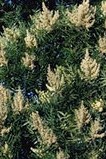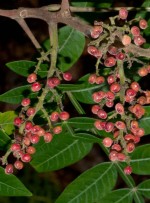 Native to Eastern United States, winged sumac is also called flame sumac and a tough shrub or small tree that is found on forest edges, old fields, meadows and roadsides. It grows quickly and suckers form colonies that are appealing when in bloom or fruit. The tiny greenish cream colored flowers are borne in pyramidal clusters 6-10” long above rings of foliage in summer and develop into showy pendulous, red fruit clusters that are attractive to birds into winter. The shiny leaves are a foot long and pinnately compound with resinous red stems. The leaf stems are winged between the leaflets giving rise to the common name. In fall the leaves turn orange-red to purple and add considerably to autumn coloration. Winged sumac is adaptable, can be grown a variety of soils and tolerates drought, heat, compaction, air and soil-borne salt. If grown in mass it provides a good wildlife habitat. A good plant for a screen, xeroscape, or informal planting. It is a member of the cashew family, Anacardiaceae, that also includes smoke tree, mango, and poison ivy. The genus name, Rhus, is the Greek name for one species, Rhus coriaria. The specific epithet, copallina, is the Latin word meaning gummy or resinous.
Native to Eastern United States, winged sumac is also called flame sumac and a tough shrub or small tree that is found on forest edges, old fields, meadows and roadsides. It grows quickly and suckers form colonies that are appealing when in bloom or fruit. The tiny greenish cream colored flowers are borne in pyramidal clusters 6-10” long above rings of foliage in summer and develop into showy pendulous, red fruit clusters that are attractive to birds into winter. The shiny leaves are a foot long and pinnately compound with resinous red stems. The leaf stems are winged between the leaflets giving rise to the common name. In fall the leaves turn orange-red to purple and add considerably to autumn coloration. Winged sumac is adaptable, can be grown a variety of soils and tolerates drought, heat, compaction, air and soil-borne salt. If grown in mass it provides a good wildlife habitat. A good plant for a screen, xeroscape, or informal planting. It is a member of the cashew family, Anacardiaceae, that also includes smoke tree, mango, and poison ivy. The genus name, Rhus, is the Greek name for one species, Rhus coriaria. The specific epithet, copallina, is the Latin word meaning gummy or resinous.
 Type: Small tree
Type: Small tree
Outstanding Feature: Autumn coloration; wildlife habitat
Form: May be single or multi-stemmed; irregular crown
Growth Rate: Fast growing, short lived
Bloom: Tiny greenish cream flowers are borne in pyramidal clusters 6-10” long in summer and are followed by showy red fruits.
Foliage: Shiny leaves one foot long are pinnately compound; turn orange red to purple in fall.
Size: 6-30’ H x 6-30’ W
Light: Full sun, light shade
Soil: Lean to humus-rich, moist to dry, neutral to acidic
Hardiness: Zones 4-8
Care: Remove suckers when necessary or plant where colonizing is desirable
Pests and Diseases: None of significance
Propagation: Division of suckers, seed.
Comments: Transplants easily; grows well in container.
